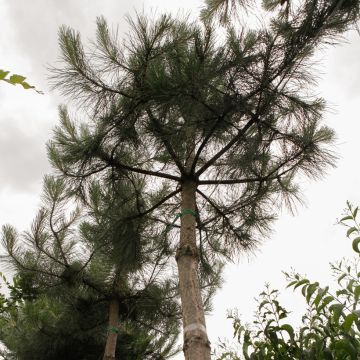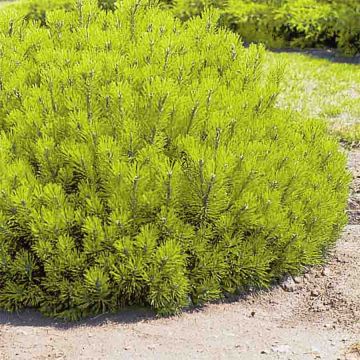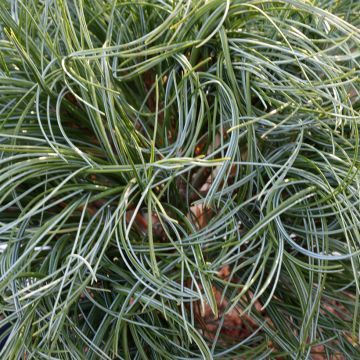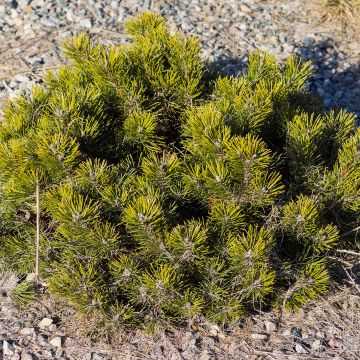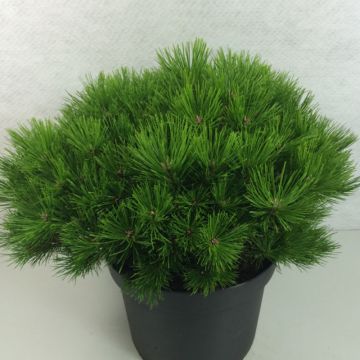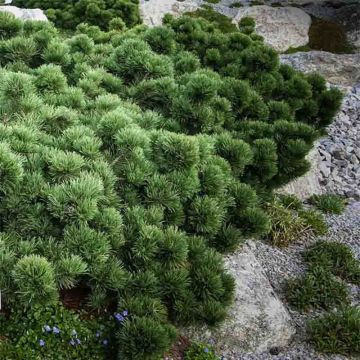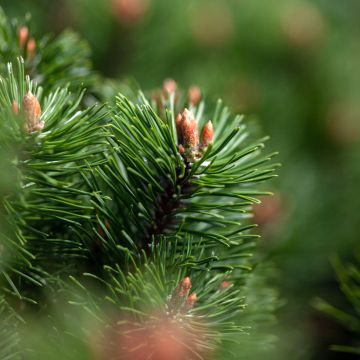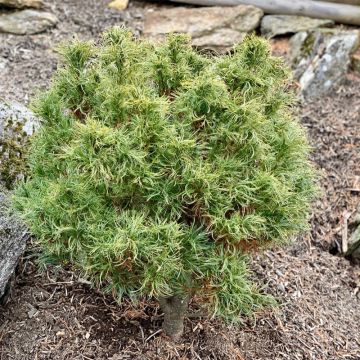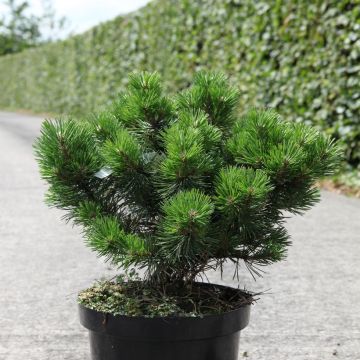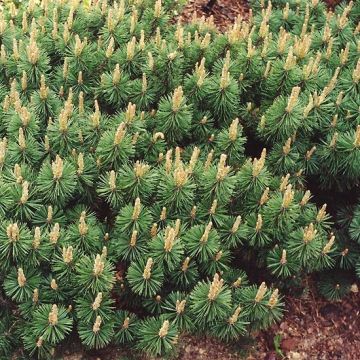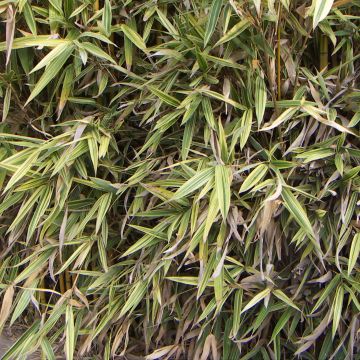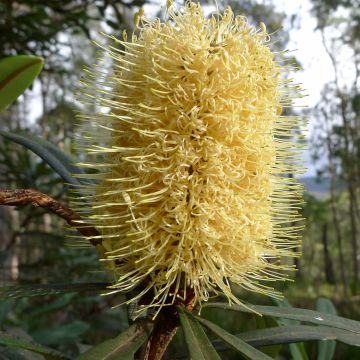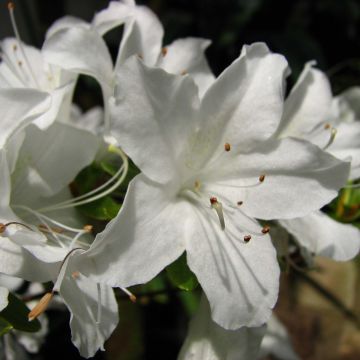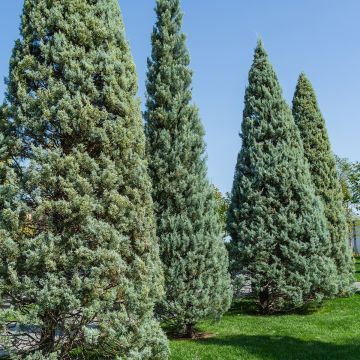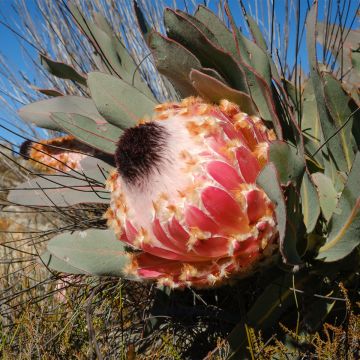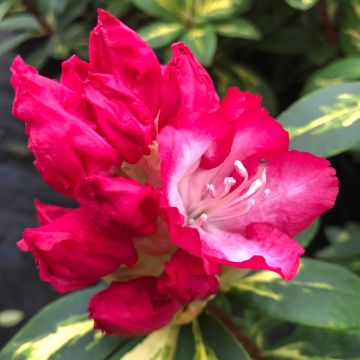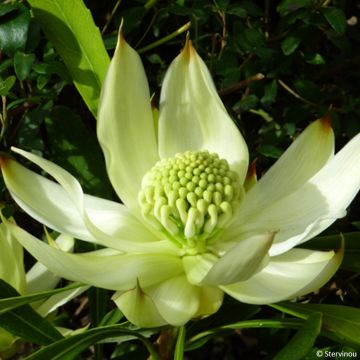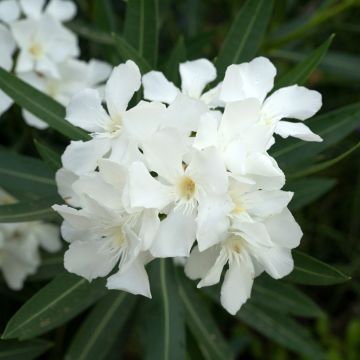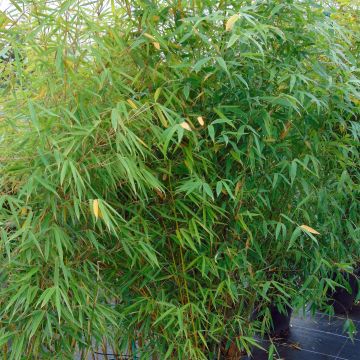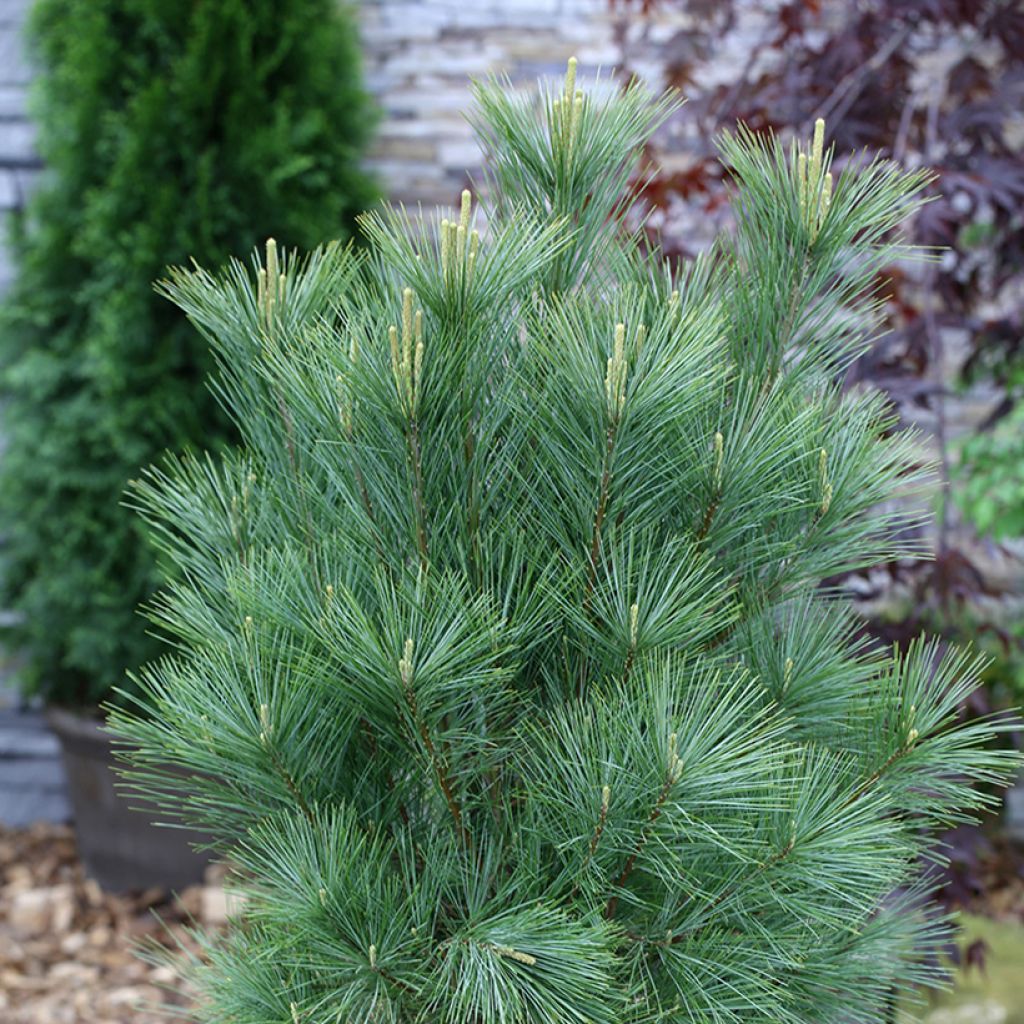

Pinus wallichiana Densa Hill - Bhutan Pine
Pinus wallichiana Densa Hill - Bhutan Pine
Pinus wallichiana Densa Hill
Bhutan Pine, Himalayan Pine, Blue Pine, Himalayan White Pine
This item cannot be shipped to the selected country
Delivery charge from €5.90
More information
Schedule delivery date,
and select date in basket
This plant carries a 24 months recovery warranty
More information
We guarantee the quality of our plants for a full growing cycle, and will replace at our expense any plant that fails to recover under normal climatic and planting conditions.
From €5.90 for pickup delivery and €6.90 for home delivery
Express home delivery from €8.90.
Does this plant fit my garden?
Set up your Plantfit profile →
Description
Pinus wallichiana 'Densa hill' is a horticultural variety that distinguishes itself from the wild Himalayan pine by its conical to columnar habit, its moderate growth, and its significantly slower growth. Over time, it forms a narrow, highly decorative tree with long, flexible and trailing needles of a beautiful blue-green colour that contrasts with the dark grey bark. Its tousled appearance gives it a friendly and decorative look throughout the year. Well-suited for small gardens and tolerant of urban pollution, it can be planted individually or in groups, in a non-limestone soil that is not too dry in the summer.
Pinus wallichiana, also known as the Weeping Himalayan Pine, is one of the pines with needles grouped in fives on short branches, just like the Eastern White Pine (Pinus strobus) and the Swiss Stone Pine (Pinus cembra). This tree belongs to the Pinaceae family, which includes many well-known conifers such as Firs, Cedars, and Larches. Native to the forests of the Himalayas from Afghanistan to Myanmar, where it grows from plains up to over 3000m (9842ft) in altitude, it can reach a height of 45m (148ft).
'Densa Hill' is a much more compact form, reaching only 6 or 7m (20 or 23ft) in height. However, patience is required as its growth is slow, approximately 15cm (6in) per year. Unlike the species, which forms a broad rounded crown, 'Densa hill' has a narrow habit, measuring between 1.50m (5ft) and 2.50m (8ft) in width. Over time, it forms a dense cone, slightly swollen at the base, with a beautiful blue-green colour. Its trunk is covered with smooth dark grey bark in the early years, which cracks and flakes over time. The trunk bears numerous, fairly thin and erect branches. The needles, grouped in fives, are long, measuring up to 10cm (4in), and very flexible. They gracefully hang down, giving the species its characteristic appearance. With a blue-green hue, they also have white bands formed by rows of stomata. The dense and light foliage, which catches even the slightest breath of wind, is truly ornamental. The cones initially stand upright but become pendant in the second year. They are large light brown cylinders, measuring from 15 to 25cm (6 to 10in) in length.
This conifer develops a rather horizontal root system and prefers moist soils, but can tolerate dry conditions once well established. It grows in non or slightly limestone soils, preferring neutral to acidic soils. Hardy down to -15°C (5°F), or even a little lower, it is sensitive to windy areas and should be planted in a sunny, sheltered location.
The Weeping Himalayan Pine 'Densa Hill' will easily find its place in small gardens. Highly ornamental, it can be planted individually to fully appreciate its beautiful trailing foliage, or integrated into a mass planting. In this case, leave some space and choose slow-growing companion plants. Chamaecyparis obtusa 'Fernspray Gold', a Japanese Hinoki Cypress with an irregular habit and foliage that turns golden in spring, will create a superb contrast of shapes and colours. To maintain a Japanese atmosphere, plant an Acer palmatum 'Crimson Queen', a small Japanese Maple that tolerates sunlight and has beautifully cut foliage that takes on warm hues throughout the year. A stunning contrast with the blue-green of your 'Densa Hill' Pine!
Report an error about the product description
Pinus wallichiana Densa Hill - Bhutan Pine in pictures
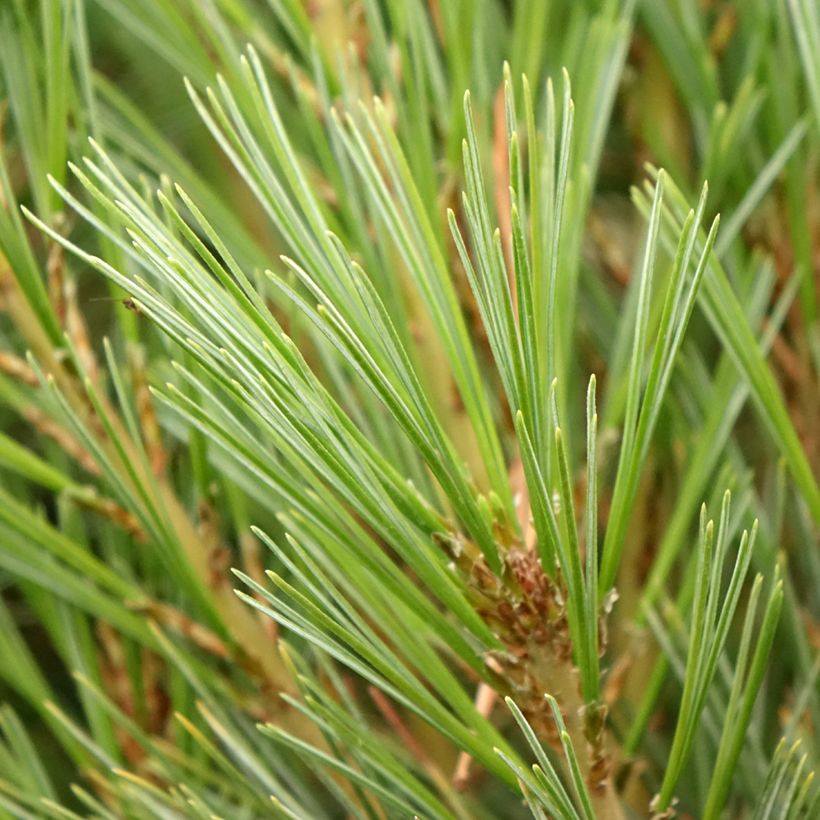

Plant habit
Foliage
Botanical data
Pinus
wallichiana
Densa Hill
Pinaceae
Bhutan Pine, Himalayan Pine, Blue Pine, Himalayan White Pine
Cultivar or hybrid
Other Pinus - Pine
Planting and care
Pinus wallichiana 'Densa Hill' is planted from September to November and from February to April in ordinary, rather moist and deep soil while being well-drained, neutral to acidic. Choose a sunny location, or at least partially shaded in hot climates, and especially sheltered from the wind which it dreads. Soak the root ball in a bucket of water for fifteen minutes before planting. Add organic amendment when planting and water generously for the first two years, and in case of prolonged drought. In very poor soil, possibly add a special conifer fertilizer every year in April and cultivate the soil in summer. This conifer is quite hardy (up to approximately -15°C (5°F)) once mature, but can be somewhat sensitive to frost in its young plant stage. It adapts to poor soils and tolerates dryness, but fears heavy soils, waterlogged in winter and summer heatwaves.
Planting period
Intended location
Care
This item has not been reviewed yet - be the first to leave a review about it.
Evergreen shrubs
Haven't found what you were looking for?
Hardiness is the lowest winter temperature a plant can endure without suffering serious damage or even dying. However, hardiness is affected by location (a sheltered area, such as a patio), protection (winter cover) and soil type (hardiness is improved by well-drained soil).

Photo Sharing Terms & Conditions
In order to encourage gardeners to interact and share their experiences, Promesse de fleurs offers various media enabling content to be uploaded onto its Site - in particular via the ‘Photo sharing’ module.
The User agrees to refrain from:
- Posting any content that is illegal, prejudicial, insulting, racist, inciteful to hatred, revisionist, contrary to public decency, that infringes on privacy or on the privacy rights of third parties, in particular the publicity rights of persons and goods, intellectual property rights, or the right to privacy.
- Submitting content on behalf of a third party;
- Impersonate the identity of a third party and/or publish any personal information about a third party;
In general, the User undertakes to refrain from any unethical behaviour.
All Content (in particular text, comments, files, images, photos, videos, creative works, etc.), which may be subject to property or intellectual property rights, image or other private rights, shall remain the property of the User, subject to the limited rights granted by the terms of the licence granted by Promesse de fleurs as stated below. Users are at liberty to publish or not to publish such Content on the Site, notably via the ‘Photo Sharing’ facility, and accept that this Content shall be made public and freely accessible, notably on the Internet.
Users further acknowledge, undertake to have ,and guarantee that they hold all necessary rights and permissions to publish such material on the Site, in particular with regard to the legislation in force pertaining to any privacy, property, intellectual property, image, or contractual rights, or rights of any other nature. By publishing such Content on the Site, Users acknowledge accepting full liability as publishers of the Content within the meaning of the law, and grant Promesse de fleurs, free of charge, an inclusive, worldwide licence for the said Content for the entire duration of its publication, including all reproduction, representation, up/downloading, displaying, performing, transmission, and storage rights.
Users also grant permission for their name to be linked to the Content and accept that this link may not always be made available.
By engaging in posting material, Users consent to their Content becoming automatically accessible on the Internet, in particular on other sites and/or blogs and/or web pages of the Promesse de fleurs site, including in particular social pages and the Promesse de fleurs catalogue.
Users may secure the removal of entrusted content free of charge by issuing a simple request via our contact form.
The flowering period indicated on our website applies to countries and regions located in USDA zone 8 (France, the United Kingdom, Ireland, the Netherlands, etc.)
It will vary according to where you live:
- In zones 9 to 10 (Italy, Spain, Greece, etc.), flowering will occur about 2 to 4 weeks earlier.
- In zones 6 to 7 (Germany, Poland, Slovenia, and lower mountainous regions), flowering will be delayed by 2 to 3 weeks.
- In zone 5 (Central Europe, Scandinavia), blooming will be delayed by 3 to 5 weeks.
In temperate climates, pruning of spring-flowering shrubs (forsythia, spireas, etc.) should be done just after flowering.
Pruning of summer-flowering shrubs (Indian Lilac, Perovskia, etc.) can be done in winter or spring.
In cold regions as well as with frost-sensitive plants, avoid pruning too early when severe frosts may still occur.
The planting period indicated on our website applies to countries and regions located in USDA zone 8 (France, United Kingdom, Ireland, Netherlands).
It will vary according to where you live:
- In Mediterranean zones (Marseille, Madrid, Milan, etc.), autumn and winter are the best planting periods.
- In continental zones (Strasbourg, Munich, Vienna, etc.), delay planting by 2 to 3 weeks in spring and bring it forward by 2 to 4 weeks in autumn.
- In mountainous regions (the Alps, Pyrenees, Carpathians, etc.), it is best to plant in late spring (May-June) or late summer (August-September).
The harvesting period indicated on our website applies to countries and regions in USDA zone 8 (France, England, Ireland, the Netherlands).
In colder areas (Scandinavia, Poland, Austria...) fruit and vegetable harvests are likely to be delayed by 3-4 weeks.
In warmer areas (Italy, Spain, Greece, etc.), harvesting will probably take place earlier, depending on weather conditions.
The sowing periods indicated on our website apply to countries and regions within USDA Zone 8 (France, UK, Ireland, Netherlands).
In colder areas (Scandinavia, Poland, Austria...), delay any outdoor sowing by 3-4 weeks, or sow under glass.
In warmer climes (Italy, Spain, Greece, etc.), bring outdoor sowing forward by a few weeks.

































